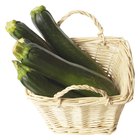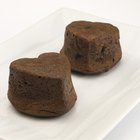ALLEKO/iStock/GettyImages
You can freeze almost any baked casserole, including eggplant Parmesan, though freezing can affect the quality of the dish. Use only the freshest ingredients and avoid recipes that call for ricotta or cottage cheese, because these don't freeze particularly well. Eggplants are notorious for absorbing oil and water, which might later dilute a frozen dish, so be sure to salt and drain them before you assemble the dish.
Safe Freezing
Eggplant Parmesan doesn't usually contain meat, but it does contain other perishable ingredients, including cheese and vegetables. To minimize bacterial growth, freeze eggplant Parmesan at 0 degrees Fahrenheit within two hours of baking it. Wrap the casserole tightly in plastic wrap or place it in a plastic freezer bag or box. Write the date on the package and use it within three to four months.
Keep the Quality
Although frozen eggplant Parmesan will stay safe indefinitely in the freezer, the quality begins to decline after you freeze it. Frozen vegetables may become limp or dry and sauces may separate. Wrapping it well helps preserve its fresh flavor, as does using it within a few months. To prevent soggy eggplant, undercook the casserole just a bit so the vegetables are still slightly crisp. Another option is to assemble and freeze the casserole before you bake it.
Thaw Out
How you thaw eggplant Parmesan is just as important as how you prepare and freeze it. To thaw a frozen casserole, place it in the refrigerator overnight. You can microwave-thaw the casserole too, but watch it closely so it doesn't burn. Another option is to cook the casserole in its frozen state. Don't thaw the casserole at room temperature, though. Thawing any frozen food on the countertop or in the sink is a risky choice because the outside of the food thaws before the interior, raising the temperature of the food. When food sits at temperatures between 40 and 140 F, bacteria multiply rapidly, according to the USDA, increasing the risk of food-borne illness.
Heat It Up
To reheat a previously frozen eggplant Parmesan, heat the oven to the temperature suggested in the recipe -- typically 450 F. Transfer the casserole to an oven-safe dish if it's in a plastic container. Cover the dish with foil so the food stays moist and heat until its bubbly. Take the foil off the pan during the last 10 minutes of cooking to brown the casserole. When heated thoroughly, a digital thermometer inserted in the center of the dish should read 165 F, according to the USDA. Double the cooking time for casseroles that have not been thawed. Wrap any leftovers and store them in the refrigerator at 40 F within two hours of serving the eggplant Parmesan.
Related Articles

Freezing a Moussaka
Do You Have to Cook Lasagna Before ...
Can I Make Quiche Ahead of Time?
Freezing a Dish With Sour Cream in It

Can You Make Chicken Fettuccine Alfredo ...

Can I Freeze Large Zucchini and Summer ...

Can You Freeze Casseroles With ...

Can Scalloped Oysters Be Prepared Ahead?

Calories in Pimento Cheese

How to Reheat Lasagna

How to Check the Internal Temp of a ...

How Fast Does Cooked Spaghetti Squash ...

How to Heat Lasagna From the Fridge

Freezing a Moussaka
Can I Freeze Cheesy Potatoes Before ...

What Is a Souffle Dish?

How to Freeze Lasagna After Baking It

Freezing Spanakopita After Baking

How to Cook Rice With Broccoli

Can I Prepare Baked Brie Ahead of Time?
References
Writer Bio
Julie Christensen is a food writer, caterer, and mom-chef. She's the creator of MarmaladeMom.org, dedicated to family fun and delicious food, and released a book titled "More Than Pot Roast: Fast, Fresh Slow Cooker Recipes."